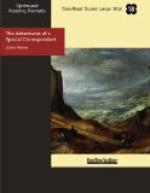The Kara Koum is formed of low sandy hills which the high winds are constantly shifting and forming. These “barkans,” as the Russians call them, vary in height from thirty to ninety feet. They expose a wide surface to the northern hurricanes which drive them gradually southward. And on this account there is a well-justified fear for the safety of the Transcaspian. It had to be protected in some efficacious way, and General Annenkof would have been much embarrassed if provident Nature had not, at the same time as she gave the land favorable for the railway to be laid along, given the means of stopping the shifting of the barkanes.
Behind these sand hills grow a number of spring shrubs, clumps of tamarisk, star thistles, and that Haloxylon ammodendron which Russians call, not so scientifically, “saksaoul.” Its deep, strong roots are as well adapted for binding together the ground as those of Hippophae rhamnoides, an arbutus of the Eleagnaceous family, which is used for binding together the sands in southern Europe.
To these plantations of saksaouls the engineers of the line have added in different places a series of slopes of worked clay, and in the most dangerous places a line of palisades.
These precautions are doubtless of use; but if the road is protected, the passengers are hardly so, when the sand flies like a bullet hail, and the wind sweeps up from the plain the whitish efflorescences of salt. It is a good thing for us that we are not in the height of the hot season; and it is not in June or July or August that I would advise you to take a trip on the Grand Transasiatic.
I am sorry that Major Noltitz does not think of coming out on the gangway to breathe the fresh air of the Kara Koum. I would offer him one of those choice regalias with which my case is well provided. He would tell me if these stations I see on my time-table, Balla-Ischem, Aidine, Pereval, Kansandjik, Ouchak, are of any interest—which they do not seem to be. But it would not do for me to disturb his siesta. And yet his conversation ought to be interesting, for as a surgeon in the Russian army he took part in the campaigns of Generals Skobeleff and Annenkof. When our train ran through the little stations that it honors only with a whistle, he could tell me if this one or that one had been the scene of any incident of the war. As a Frenchman I am justified in questioning him about the Russian expedition across Turkestan, and I have no doubt that my fellow passenger will be pleased to gratify me. He is the only one I can really trust besides Popof.
But why is Popof not in his seat? He also is not insensible to the charms of a cigar. It would seem that his conversation with the engineer has not finished yet.
Ah! Here he is coming from the front of the luggage van. He comes out of it and shuts the door; he remains for a moment and is about to take a seat. A hand which holds a cigar, is stretched out toward him. Popof smiles and soon his perfumed puffs are mingling voluptuously with mine.




